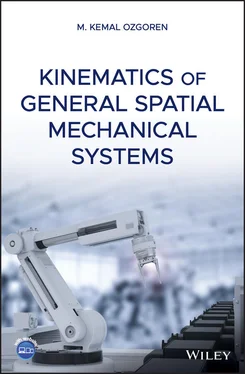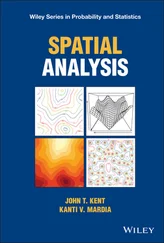This book places the main emphasis on the analytical and semi‐analytical solution methods for the kinematic problems concerning the systems to be studied. An analytical solution is such that all the unknown variables are obtained with closed‐form expressions in terms of the known variables. On the other hand, a semi‐analytical solution is such that a large number of the unknown variables are again obtained with closed‐form expressions in terms of the known and a small number of judiciously selected special unknown variables. Afterwards, these small number of special unknowns are found by solving an equal number of consistency equations by means of a suitable numerical method. Due to the preference of the analytical and semi‐analytical solution methods, the purely numerical solution methods are kept beyond the scope of this book.
One of the major advantages of the analytical and semi‐analytical solution methods is that the multiplicities and singularities are readily identified as the by‐products of the solution procedure. Owing to the closed‐form (or mostly closed‐form) expressions, the consequences of the multiplicities and singularities can also be studied easily. This way, the motion planning studies are also facilitated.
On the other hand, the analytical and semi‐analytical solution methods necessitate that the orientations and locations of the links (i.e. the rigid body members) of the studied system be expressed separately with all the characteristic details shown explicitly as a preparation for the subsequent symbolic manipulations. Therefore, the compact mathematical formulations that combine the orientations and locations into single algebraic entities (such as homogeneous displacement matrices, screws, dual quaternions, etc.) are not favored in this book. Yet, these compact algebraic entities are actually advantageous in many ways. For example, they are indeed very suitable for writing the equations of the kinematic chains and loops compactly and briefly. They are also suitable for the efficient execution of the computations related to those equations. However, they are not very suitable for the detailed symbolic manipulations that are required for the analytical treatments, which constitute the basis of this book.
The main topics that are covered in this book are indicated and briefly explained below.
The Necessary Mathematics of Spatial Kinematics ( Chapters 1, 2, 3, and 4):The relevant concepts, theorems, and formulas are explained and discussed. Additionally, a simple and neat notation is introduced that clearly distinguishes vectors and their column matrix representations in different reference frames. This notation, together with the accompanying algebraic rules, turns out to be very convenient for the symbolic manipulation of the kinematic relationships. Thus, it facilitates obtaining the analytical and semi‐analytical solutions.
Kinematic Constituents of a Mechanical System ( Chapters 5and 6):The links, the kinematic elements on the links, and the joints (i.e. the kinematic pairs formed by the mating kinematic elements of the connected links) are described mathematically by means of the appropriately defined reference frames, the constant geometric parameters of the links and the joints, and the joint variables that describe the relative positions of the mating kinematic elements with respect to each other.In this book, the links and the kinematic elements of the joints are assumed to be rigid. In other words, the mechanical systems with flexible links and/or flexural joints are not taken into the scope of this book.
Kinematic Formation and Formulation of a Mechanical System ( Chapters 5and 6):The necessary equations are written in the position, velocity, and acceleration domains in order to describe the kinematic relationships concerning the open, closed, and hybrid kinematic chains, by which the kinematic constituents are interconnected to form a mechanical system.
Kinematic Treatment of Serial Manipulators ( Chapters 7, 8, and 9):The treatment includes the forward kinematic formulations and the inverse kinematic solutions in the position and velocity domains. The results are extended to the acceleration domain, too. The treatment also includes discussions on the multiplicities in the position domain and the analysis of the position and motion singularities. The singularities are discussed considering their consequences in the task and joint spaces. The singularity analysis suggests certain compatibility conditions on the planned motion of the end‐effector. These compatibility conditions, if obeyed, eliminate the necessity of avoiding the singularities. On the contrary, without avoiding the singularities, it becomes possible to execute certain tasks, which could not be executed otherwise.
Kinematic Treatment of Parallel Manipulators ( Chapter 10):The treatment includes the forward and inverse kinematic solutions in the position and velocity domains. The results may be extended, if desired, to the acceleration domain, too. Concerning the multiplicities in the position domain, the treatment includes discussions on the two different sets of posture multiplicities associated with the forward and inverse kinematic solutions. Concerning the singularities, the treatment includes the analysis of four different types of singularities, each of which is designated by one of the following phrases: position singularity of forward kinematics, motion singularity of forward kinematics, position singularity of inverse kinematics, and motion singularity of inverse kinematics. The singularity analysis shows that the manipulator becomes uncontrollable through its actuated joints in the position and motion singularities of forward kinematics. Therefore, the singularities of forward kinematics must be avoided. The singularity analysis also shows that the manipulator remains controllable through its actuated joints in the position and motion singularities of inverse kinematics, provided that the desired motion of the end‐effector be specified according to certain restrictive compatibility conditions. Therefore, the singularities of inverse kinematics need not be avoided, if the restricted motion of the end‐effector is acceptable or desirable for the task to be executed.
Kinematic Treatment of the Mechanisms with Simple Contact Joints ( Chapters 5and 6):In the position domain, the treatment includes the identification of the independent loops, writing the corresponding loop closure equations, and then solving them to obtain the unspecified joint variables as functions of the specified ones. The position domain treatment also includes discussions on the multiple solutions and the position singularities associated with the specified joint variables. In the velocity and acceleration domains, the treatment includes deriving the velocity and acceleration constraint equations and solving them to obtain the unspecified joint variable rates in terms of the specified ones. The velocity and acceleration analyses also include discussions on the motion singularities associated with the specified joint variables. There are several examples of such mechanisms in Chapters 5and 6.
Kinematic Treatment of the Mechanisms with Rolling Contact Joints ( Chapter 6):The rolling contact joints, i.e. the gear and cam joints, need somewhat different treatment as compared with the other simple contact joints. In particular, the mechanisms that contain cam joints with sticking friction, i.e. with the rolling‐without‐slipping property, happen to be non‐holonomic systems that have different degrees of freedom in the position and velocity domains. Therefore, the mechanisms that involve rolling contact joints with the rolling‐without‐slipping property are treated differently in the order of obtaining the kinematic solutions in the position and velocity domains. For such mechanisms, the kinematic solution is first obtained in the velocity domain and then the corresponding kinematic solution in the position domain is obtained by means of a subsequent numerical integration. The most typical samples of such mechanisms are the mechanisms that involve gear joints, because the gear joints are kinematically equivalent to the cylindrical or conical cam joints with the rolling‐without‐slipping property. A typical example of such a cam mechanism is presented in Chapter 6. The kinematic solutions of that cam mechanism in the position and velocity domains are obtained both in the cases of rolling with slipping and rolling without slipping.
Читать дальше












